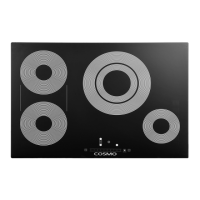38
Choosing Cookware
The cookware material determines how evenly and quickly heat is transferred
from the surface element to the pan bottom.
Recommended
• Aluminum - Excellent heat conductor. Some types of food will cause
it to darken (anodized aluminum cookware resists staining and
pitting). If aluminum pans slide across the ceramic cooktop, they may
leave metal marks which will resemble scratches. Remove these
marks immediately. Because of its low melting point, thin weight
aluminum should not be used.
• Copper - Excellent heat conductor but discolors easily. May leave
metal marks on glass-ceramic (see Aluminum above). Do not let
these pots boil dry. Overheated metal can bond to glass cooktops.
An overheated copper bottom pot will leave a residue that will
permanently stain the cooktop if not removed immediately.
• Stainless Steel - Slow heat conductor with uneven cooking results. Is
durable, easy to clean and resists staining.
• Enamel (painted) on Cast Iron - Bottom of pan must be smooth
coated and smooth.
Not Recommended
• Enamel (painted) on Steel - Heating empty pans can cause
permanent damage to cooktop glass. The enamel can melt and
bond to the ceramic cooktop.
• Cast iron - A poor heat conductor, slow to absorb heat but retains
heat very well. Will scratch the glass surface. Not recommended
unless designed specifically for use on ceramic cooktops.
• Glass-ceramic - Slow heat conductor. Poor performance, and will
scratch the glass surface.
• Stoneware - Poor performance, and may scratch the glass surface.

